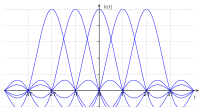
Photo from wikipedia
The massive multiple-input-multiple-output (MIMO) technology relies on many antennas at base stations to offer high throughput to meet 5G network requirements. However, each base station requires accurate channel state information… Click to show full abstract
The massive multiple-input-multiple-output (MIMO) technology relies on many antennas at base stations to offer high throughput to meet 5G network requirements. However, each base station requires accurate channel state information during channel estimation. Pilot contamination is one of the significant challenges that limit higher order MIMO deployment because it causes channel estimation error. In this paper, a Wiener predictor (WP) using the temporal-based prediction technique was first proposed and then extended as the coordinated WP (CoWP). The WP method is based on prediction using information that has been stored and processed at the base station from a modified subframe, whereas the extended CoWP method requires neighboring base station coordination to assign collection and prediction with other base stations. Results showed a reduction in channel estimation error due to pilot contamination after the Wiener-based prediction and coordinated base station techniques were used. The proposed CoWP technique can increase the performance of channel estimation error by up to 25 and 30 dB relative to the performance of other research technique and conventional MMSE channel estimation. This paper indicates that the pilot contamination effect can be minimized by exploiting the temporal dimension, and this approach increases the number of MIMO order for future 5G base stations, which currently limited due to pilot contamination.
Journal Title: IEEE Access
Year Published: 2018
Link to full text (if available)
Share on Social Media: Sign Up to like & get
recommendations!